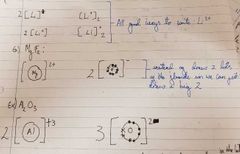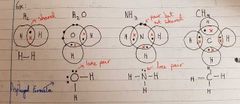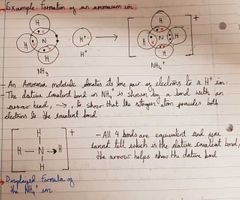![]()
![]()
![]()
Use LEFT and RIGHT arrow keys to navigate between flashcards;
Use UP and DOWN arrow keys to flip the card;
H to show hint;
A reads text to speech;
50 Cards in this Set
- Front
- Back
|
What is an isotope? |
Atoms of the same element with a different number of neutrons / different mass numbers |
|
|
What are cations? |
Positive ions |
|
|
What are anions? |
Negative ions |
|
|
What positive ions do you need to remember? |
Hydrogen = H+ Zinc = Zn2+ Silver = Ag+ Ammonium = NH4 + |
|
|
What are the negative ions you need to remember? |
Hydroxide = OH- Sulfate = SO4 2- Nitrate = NO3 - Carbonate = CO3 2- |
|
|
What is the atomic number? |
The number if protons |
|
|
What is the mass number? |
The total number of Protons and neutrons |
|
|
What does the ionic charge mean? |
Ions = atoms that have lost or gained and electron and now have an overall charge Negative charge means an atom has gained an electron to achieve a full outer shell Positive charge means an atom has lost an electron to achieve a full outer shell |
|
|
What rules are ionic equations written with? |

Write the full balanced equation
For aqueous ionic substances write the ions separately
Leave the formulae of all solids, liquids and gases in full
Cancel all spectator ions - those that appear separately on both sides of the equation
Remember to include state symbols at the end |
|
|
What is the relative isotopic mass? |
The mass of an isotope relative to 1/12th of the mass of an atom of carbon-12 |
|
|
What is the relative molecular mass? |
The weighted mean mass of a molecule compared with 1/12th of the mass of an atom of carbon-12 |
|
|
What is the relative atomic mass? |
The weighted mean mass of an atom of an element relative to 1/12th of an atom of carbon-12 |
|
|
What other ions do you need to remember? |
Nitrite = NO2- Hydrogen Carbonate = HCO3- Sulfite = SO3 2- Phosphate = PO4 3- |
|
|
How do we calculate the relative molecular mass? |
We add up all of the relative atomic masses of the atoms in the molecule |
|
|
How do you calculate the relative atom mass of an element? |
(Ab1 × mass 1) + (Ab2 × mass 2) / 100 |
|
|
What is the amount of substance (n) ? |
A quantity used to count the number of particles in a substance, measured in a unit called the mole |
|
|
What is a mole? |
One mole is the amount of a substance that contains 6.02 x 10^23 particles |
|
|
What is Avogadros Constant? |
The avogadro constant is 6.02 x 10^23 mol^-1, the number of particles in each mole of carbon-12 |
|
|
What is Molar mass? |
The mass in grams of one mole of the compound |
|
|
How do we calculate the molar mass of a compound? |
The units of molar mass are gmol^-1 To calculate the molar mass we add up the different mass numbers of the elements in the compound For example the molar mass of carbon is 12gmol^-1 |
|
|
How do we calculate the amount of substance (n)? |
Amount of substance = Mass (m)/ Molar mass (M) (n) This equation is essentially the one we use to find the moles of something, the mass in grams, or the MR It basically looks like this: Moles = mass (grams) / Mr (gmol^-1) |
|
|
What is the molecular formula? |
The number of atoms of each element in a molecule |
|
|
What is the empirical formula of a compound? |
The simplest whole number ration of atoms of each element in a compound |
|
|
What are examples of the Empricial formula? |
The molecular formula of nitrogen dioxide is: But its empirical formula is: NO2 We divide by 2, the smallest number out of 2 and 4, to find the simplest whole number ratio of 1:2 |
|
|
What are hydrated salts? |
Solutions of salts and water that form a crystalline solid |
|
|
What is the water of crystallisation? |
The water that is chemically bonded into a crystal structure (Aka the water that makes a dry salt a hydrated salt) |
|
|
What is an anhydrous salt? |
A compound in which all water molecules are removed |
|
|
How do we calculate the empirical formula from mass? |
We convert the mass they have given us into moles using the equation Moles = mass/ Molar mass We then rewrite the moles we got into a ratio, to find the smallest whole number ratio we divide by the smallest whole number We then write the empirical formula using the ratio which tells us how many atoms of each element we need |
|
|
How do we calculate the molecular formula of a compound? |
So first we convert the mass into moles using the equation: Moles = mass (grams) / Molar Mass (M) Then we put these into a ratio and divide by the smallest whole number to figure out the empirical formula Then we write the relative mass of the empirical formula by adding up the mass numbers of the elements in the formula In this question they would have given us the total relative molecular mass of a compound. We want to find how many of our empirical formula fit into it so we divide the compound mass by the relative mass of our empirical formula We then multiply each element in our empirical formula by the answer we just got to find the molecular formula |
|
|
How do we calculate the number of water molecules in a hydrated salt if we are given the total molar mass? |
Say we are given the question: Ni(NO3)2 . xH2O, Calculate the value of x when the total molar mass is 290.7 gmol^-1 First we want to calculate the molar mass of Ni(NO3). To do this we just add up the mass numbers of the elements in the compound this = 183 Then we subtract them from the total molar mass of 290.7 which equals 107.7 We then divide 107.7 by the molecular mass of water, we do this to see how many water molecules can fit into 108. When we do this we get 5.9 and then round to 6 so x =6 |
|
|
When do we round up or multiply when we are calcualting the empirical formula of a compound? |
When we are trying to write the simplest whole number ratio for the empirical formula, sometimes when we divide by the smallest number we can get a decimal such as: 1: 3.92 , in this case we round 3.92 to 4 since its so close But in the case we get 1:1.5 we can't round to 2 because its too far away, instead we multiply by 2 to get the simplest whole number ratio of 2:3 |
|
|
What is the rule for rounding or multiplying when calculating the empirical formula? |
Round if VERY CLOSE to the whole number - no more than 0.1 away When to multiply will be obvious: Anything with 0.25 means we x4 Anything with 0.33 means we x3 Anything with 0.5 means we x2 |
|
|
How do we calculate the number of atoms in a molecule? |
First we calculate the number of mols using the equation n=m/M Then we do mols x avogadros constant |
|
|
How do we calculate the empirical formula if we are giving the percentage by mass? |
First we do the percentage by mass of each element divided by the mass number of each element Then we divide the ratio by the smallest whole number ratio Then we should get the simplest whole number ratio, if not we multiply to make them a whole number |
|
|
What is ionic bonding? |
The electrostatic attraction between psotitive and negative ions. Holds together positive ionss and negative ions in ionic compounds |
|
|
How do we show ionic bonding using a diagram? |

We do a Dot and cross diagram using square brackets
If we are given the formula and we want to show it and one of the elements we need 2 of, we can draw the square bracket for one and just draw a big 2 infront of it |
|
|
What are giant ionic compounds? |
Contains billions of billions of ions held in a giant ionic lattice |
|
|
Why are ionic compounds solid at room temp? |
There is insufficient energy to voercome the strong electrostatic forces of attraction between the oppositely charged ions in the giant ionic lattice This is also why they have high MP and BP |
|
|
What is solubility like in ionic compounds? |
Usually soluble in polar solvents, like water. Polar water molecules break down the lattice and surround each ion in solution In a compound made of ions with large charges, the ionic attraction may be too strong for water to be able to break down the lattic structure - the compound will not then be very soluble |
|
|
What is electrical conductivity like in ionic compounds? |
In a solid state, an ionic compound does not conduct electricity but once melted or dissolved in water, the ionic compound does conduct electricity This is because in a solid state the ions are fixed in position in the latice so they cant move to carry an electrical charge, this means they cant conduct electricity In liquid or molten state they can conduct electricity as the solid ionic lattic breaks down so the ions are now free to move |
|
|
What is covalent bonding? |
The strong electrostatic attraction between a pair of electrons and the nuclei of the bonded atoms |
|
|
What is the displayed formula? |

Shows the relative positioning of atoms and the bonds between them as lines
Paired electrons that are not shared are called lone pairs, these can also be added to displayed formulae |
|
|
What are multiple covalent bonds? |

A multiple covalent bond exist s when 2 atoms share more than one pair of electrons |
|
|
What are double and triple covalent bonds? |

The electrostatic attraction is between 2/3 shaired pairs of electrons and the nuclei of the bonding atoms |
|
|
What is a dative covlanet bond/ coordinate bond? |

A covalent bond which the shared pair of electrons has been supplied by one of the bonding atoms only
In a dative covalent bond the shared pair was originally a lone pair of electrons on one of the bonded atoms
Represented by an aroow in the displayed formula |
|
|
What is metallic bonding? |
The strong electrostastic attraction between positive ions and delocalised electrons |
|
|
What is the structure like in metals? |
The positive ions are fixed in position, maintaining the structure and shape of the metal The delocalised electrons are mobile and are able to move throughjout the structure |
|
|
What is the electrical conducitivty like in metals? |
Can conduct electricity in solid and liquid states, when a voltage is applied across the metal the delocalised electrons can move to carry the charge throughout the structure |
|
|
What is the MP and BP like in metals? |
High temperature are needed to provide the large amount of energy needed to overcome the strong electrostatic attraction between the positive ions and electrons |
|
|
What are the properties of Giant covalent structures? |
High MP and Bp - high temps are needed to provide the large quatnity of energy needed to break the strong covalent bonds Insoluble in almost all solvents. The covalent bonds holding together the atoms in the lattice are far too strong to be broken by interaction with solvents Cant conduct electricity aside from graphene and graphite |

